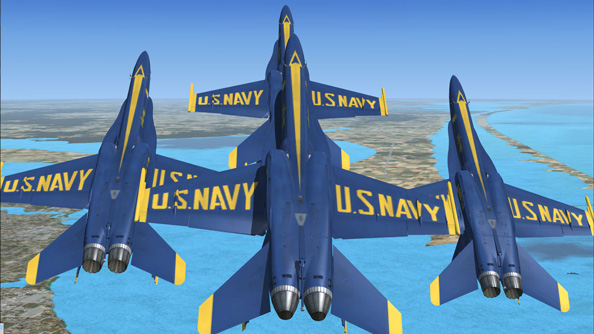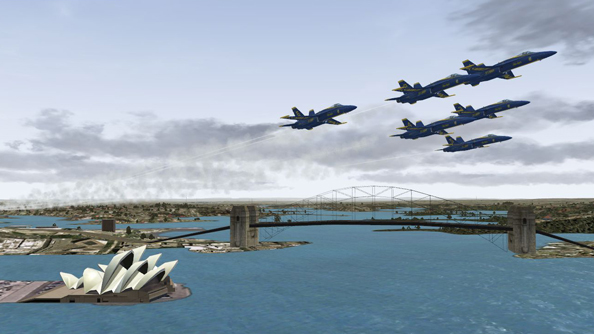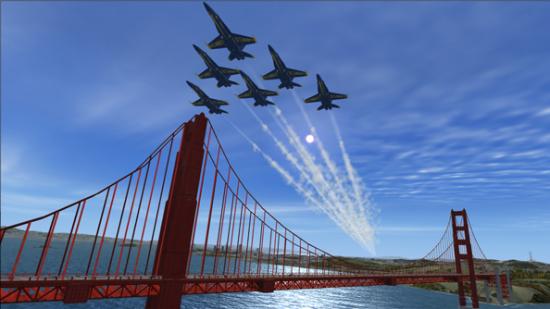One thing that never fails to amaze about the flight sim community, is how far people will go to emulate the real world of flight. Virtual airlines task pilots with flying commercial airliner routes in-game, adhering to authentic schedules and maintaining strict rotas. Air Traffic Controllers think nothing of getting home after work, firing up their network and spending a few hours guiding other players around the simulated skies across the internet. But for sheer dedication, few beat the pilots of the FSX Blue Angels, the Microsoft Flight Simulator X version of the US Navy’s flying aerobatic team. This past weekend saw the annual ‘Fleet Week’ show and we took the opportunity to catch up with Event Coordinator and FSX Blue Angel #8 – ‘Skyman’, to find out a little more about what goes into being the FSX community’s premier aerobatic organisation…
The FSX Blue Angels (FSXBA) was created back in 2008 with a mission to replicate the precision flying and professionalism of the real Blue Angels. Part of that is the regular performance in online air shows, showing off the individual and team flying skills of the 13 pilots on the team.
PCGamesN: You just had the 2012 Fleet Week air show. How did that go for you?
‘Skyman’: The Fleet Week 2012 Air Show was a great success for the FSXBA, and all of the performers who participated. This was our fourth and final show of the 2012 season, and we are proud of all of those involved in the show and of from each and every member of our team. The weeks and months of practice, planning, and attention to detail really paid off!
What is an FSXBA training schedule like? I expect you have to give up a lot of your own time to master the routines?
The team practices three times a week during the show season, on Sundays, Tuesdays and Thursdays for approximately two hours per practice. On weeks prior to a scheduled air show, we practice every evening leading up to show day.
The members of the FSX Blue Angels live all across the United States; some in the East Coast, others in the West Coast and Southern U.S., and one member in Canada. Technology allows us all to meet in the same virtual space for practices and shows. The only drawbacks are the scattered time zones.
What makes up a typical day of duty during show weeks?
The amount of work involved for the team depends on which type of show we will be performing. We have two classifications of air shows. Away shows that are hosted by other teams or organizations, and home shows, where our team will host, organize and execute the entire event. Our last show, Fleet Week 2012, was one of our home shows performed on behalf of our many sponsors. These events usually require the team to be present for the entire program, usually between eight to ten hours.
At every FSX Blue Angel home show, the team opens its simulator and communication servers for the performers approximately one hour prior to the start of the event (two hours for an away show). The Team Lead, Narrator, Events Coordinator, and Maintenance Officer (MO), handle the majority of the air show logistics to include air boss, video and audio management, and overall air show production. Additional FSXBA team members are present to assist upcoming and finishing performers as they are moved from our lobby channels, to our live performance communications channels located on our TeamSpeak Server.
About two hours prior to our performance, our team will meet in a private TeamSpeak channel to prepare for our upcoming performance by briefing the event, limited practice, and covering any questions or concerns. Thirty minutes prior to performance time, the team reassembles in the show broadcast server and completes its final checks. This is where each member checks and double checks that he has the correct hardware and software setting correct prior to the performance. After each show, the entire team greets those guests in our servers, and conducts a post-show debrief of the completed performance.
Despite all the planning, has a show ever gone wrong? What happens in those circumstances?
Each show has brought with it its own set of challenges. Several years ago, we had our main streaming server go down an hour before a show. Due to proper preparation and planning, we had standby streamers and servers ready for employment and the problem was fixed quickly. We have had performers crash their aircraft during their performance, in which case we immediately cut the video stream, and make notes to conduct a better screening process for our future participants.
During Fleet Week 2012, we had a few performers fail to show during their scheduled performance times, which caused a gap between acts. Because of this, we designated ‘fill-in’ performers to fill the gaps present in the schedule. Ultimately, we try our best to foresee and plan for any problems or adverse circumstances that may arise, and keep a record of ‘lessons learned’ from previous shows so that we do not repeat the same mistakes.
What makes for a good team member?
Finding a good formation team can be extremely challenging for many reasons. First and foremost, flying multi-jet formations in FSX is not easy. It takes a lot of practice by all team members involved. Most flight simulator hobbyists are not able or willing to put forth the large amount of time and effort required to get a successful team going.
The other major obstacle is the technology and expenses involved. In order to fly a decent formation in FSX, the simulator pilot needs a very good gaming computer, a certain type of flight control system, a head tracking unit such as TRACKIR, and a good internet connection. The expenses involved in the aforementioned can add up very quickly and can prove to be too expensive for some.
Finally, and most importantly, having the right guys to do the right job. All of the members of the FSX Blue Angels are very versatile, and all are team players. The majority of the guys that are a part of the team hold multiple positions outside of their primary job so that the team can function properly. These ‘collateral duties’ include everything from the webmaster, to the newspaper editor, to running the monthly screenshot competitions. Everyone is dedicated toward the cause.
So if someone wanted to apply to join, what would you be looking for?
First and foremost, we look at the applicant’s personality. Someone who is team-oriented, professional, and can take criticism and come back for more. They must share and personify the team’s image and ideas at all times, whether it’s flying in the Demo, assisting guests in our servers, or making posts on Facebook, professionalism and courtesy are paramount. Following the personality assessment, we look for three things: skill, availability and equipment. A pilot must display above average abilities in aircraft and simulator knowledge, basic pilotage and formation flying, and they must be able to make our weekly practice sessions and attend the three to four events we execute each year.
I assume you fly with maximum reality settings?
Yes, with the exception of ‘Aircraft Collisions’ and ‘G-Force Effects’ we do fly with full realism. The aircraft collision detection system employed by FSX registers collisions at about 10 feet of separation and does not offer a realistic collision model for what we do. The G tolerance (i.e. Black Out/Red Out) effects offered by simulator do not accurately represent the tolerances of the real Blue Angels nor those required for our routines. Most of the display and extra features of FSX have been disabled and tweaked to maximize frame rate, simulator, and network performance, and to minimize technical issues. Only the team’s video streamer has his graphics and scenery settings maximized for production quality.
What add-on packs/scenery do you use?
As with the real U.S. Navy Blue Angels, we are based at Naval Air Facility El Centro, in El Centro California during the training and off-season, and Naval Air Station Pensacola in Pensacola, Florida during the show season from March to November. We have replicated those two facilities in our add-on scenery packages, to give as much realism as possible to our online events. When we have a performance at a facility that does have the proper infrastructure, our in-house scenery makers will make the necessary additions (show box, mile markers, ground personnel, communications cart, etc.) in order for our team to have a successful performance.
For the six blue jets used during the demonstration, the team uses an enhanced version of the FSX: Acceleration Boeing F/A-18 Hornet. The flight characteristics and systems of the aircraft have been augmented to better match the flight handling of the real F/A-18 Hornet, and visual effects have been added for a better look during our shows. Our two-seater F/A-18 D Hornet is a customized version of the Captain Sim F/A-18 D Hornet. The two-seater has been fitted with the same changes and alterations as the previously mentioned aircraft. The third and final aircraft is the Captain Sim C-130 Hercules which is used during the ‘Fat Albert’ portion of our routine.
We also have specially-made ground crew such as the narrator, events coordinator, maintenance officer and flight surgeon that are used as our ‘eyes, ears, and voice’ on the ground as we are performing.
Our scenery packages and F/A-18 Hornets are available on our website for anyone to download and use, provided it is not used for any commercial endeavours.
What led you to do all this in the first place?
The conditions seemed right at the time. The ideas of creating the FSX Blue Angels surfaced shortly after the release of Microsoft Flight Simulator X: Acceleration, which included the Boeing F/A-18 Hornet. Over the course of a few weeks, a small group formed in FSX multiplayer servers for the sole purpose of practising formation flight. Since all those involved had Blue Angels aircraft, and we enjoyed formation flying, the decision was made that we would concentrate our efforts in recreating the famous demonstration routine or ‘Demo’ performed by the U.S. Navy Flight Demonstration Squadron. In late November of 2008, the FSX Blue Angels were born.
You can find out more about life in the FSX Blue Angels, and watch the team’s many performances over at fsxblueangels.com.
You’re reading theflight simchannel at PCGamesN. We combine new, original content with feeds from the best flight sim websites and reader submissions. For the best, new stuff about all flight sims, check ourhomepageandfollow ourflight simTwitter accountfor regular updates. Check our retail partner SimStop forFlight Simulator add onsand more.
